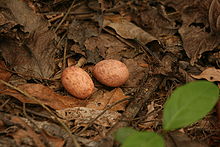Pauraque
| Pauraque | |
|---|---|

| |
| N. a. yucatanensis in Belize | |
| Scientific classification | |
| Domain: | Eukaryota |
| Kingdom: | Animalia |
| Phylum: | Chordata |
| Class: | Aves |
| Clade: | Strisores |
| Order: | Caprimulgiformes |
| Family: | Caprimulgidae |
| Genus: | Nyctidromus |
| Species: | N. albicollis
|
| Binomial name | |
| Nyctidromus albicollis (Gmelin, JF, 1789)
| |

| |
The pauraque (Nyctidromus albicollis) – also called the common pauraque to distinguish it from similar
Taxonomy
The pauraque was formally described in 1789 by the German naturalist Johann Friedrich Gmelin in his revised and expanded edition of Carl Linnaeus's Systema Naturae. He placed it with all the other nightjars in the genus Caprimulgus and coined the binomial name Caprimulgus albicollis.[3] Gmelin based his description on the "white-throated goatsucker" that had been described in 1783 by the English ornithologist John Latham in his A General Synopsis of Birds. Latham had examined a preserved specimen in London that was thought to have come from Cayenne, French Guiana.[4] The pauraque is now placed with Anthony's nightjar in the genus Nyctidromus that was introduced in 1838 by the English ornithologist John Gould.[5][6] The genus name combines the Ancient Greek nukti- meaning "nocturnal" or "night-" with -dromos meaning "-racer". The specific epithet albicollis combines the Latin albus meaning "white" with the Modern Latin -collis" meaning "-necked".[7]
The common name "pauraque" may be an onomatopoeia from the bird's wailing call.[8]
Six subspecies are recognised:[6]
- N. a. insularis Nelson, 1898 – Tres Marías Is. (off w Mexico)
- N. a. merrilli Sennett, 1888 – south Texas (USA) and northeast Mexico
- N. a. yucatanensis Nelson, 1901 – west, east Mexico (including Yucatán Peninsula) to central Guatemala
- N. a. gilvus Bangs, 1902 – central, east Panama and north Colombia
- N. a. albicollis (Gmelin, JF, 1789) – south Guatemala to northwest Peru; east Colombia, northwest Peru and Venezuela through the Guianas and Brazil
- N. a. derbyanus Gould, 1838 – Bolivia, central, south Brazil, Paraguay and northeast Argentina

Description

This medium-sized nightjar is 8.7–11 in (22–28 cm) long and has two colour morphs, the plumage being variegated greyish-brown or rufous-brown. It is long-tailed and has broad rounded wings. The buff 'eye-ring' and 'facial stripe' contrast with the reddish sides of the face.[2]
The adult male pauraque has a white band near the wing tips, and the outer tail feathers are mainly white. The female's wing band is narrower and the white in the outer tail is more restricted. There are seven subspecies of the pauraque, differing in size and greyness.[2]
The male pauraque's song is very variable, but includes a whistled weeeow wheeooo ("who-r-you"), soft puk puk and a whip given in the courtship flight as he flutters around the female. Her call is a rapid succession of whip sounds.[2]
Distribution and ecology
The breeding range of the common pauraque extends from southern Texas to the lower Paraná River region. Most populations are all-year residents, although the U.S. breeders (N. a. merrilli) may winter in eastern Mexico.[2]
At the southern end of its range, subspecies N. a. derbyanus ranges from central and southern

It is found in open
No nest is made; the two elongated and elliptical pinkish eggs are placed upon the bare ground or
References
- ^ . Retrieved 12 November 2021.
- ^ ISBN 1-873403-48-8.
- ^ Gmelin, Johann Friedrich (1789). Systema naturae per regna tria naturae : secundum classes, ordines, genera, species, cum characteribus, differentiis, synonymis, locis (in Latin). Vol. 1, Part 2 (13th ed.). Lipsiae [Leipzig]: Georg. Emanuel. Beer. p. 1030.
- ^ Latham, John (1783). A General Synopsis of Birds. Vol. 2, Part 2. London: Printed for Leigh and Sotheby. pp. 596–597, No. 7.
- ^ Gould, John (1838). Icones Avium, or figures and descriptions of new and interesting species of birds from various parts of the globe. Vol. Part 2. London: self. Plate 12 text (plates not numbered).
- ^ Rasmussen, Pamela, eds. (January 2022). "Frogmouths, Oilbird, potoos, nightjars". IOC World Bird List Version 12.1. International Ornithologists' Union. Retrieved 7 July 2022.
- ISBN 978-1-4081-2501-4.
- ^ Skutch, Alexander F. (1972). "Pauraque". Studies of Tropical American Birds. Publications of the Nuttall Ornithological Club: Number 10. Cambridge, Massachusetts: Nuttall Ornithological Club. pp. 3–21 [6].
- ^ Azpiroz, Adrián B.; Menéndez, José L. (2008). "Three new species and novel distributional data for birds in Uruguay". Bull. B.O.C. 128 (1): 38–56.
- ^ Accordi, Iury Almeida; Barcellos, André (2006). "Composição da avifauna em oito áreas úmidas da Bacia Hidrográfica do Lago Guaíba, Rio Grande do Sul" [Bird composition and conservation in eight wetlands of the hydrographic basin of Guaíba lake, State of Rio Grande do Sul, Brazil]. Revista Brasileira de Ornitologia (in Portuguese and English). 14 (2): 101–115.
- S2CID 221823941.
- PMID 23505644.
External links
- "Pauraque media". Internet Bird Collection.
- Pauraque Stamps[usurped] for Suriname and Venezuela at bird-stamps.org[usurped]
- Common Pauraque photo gallery at VIREO (Drexel University)
- Common pauraque species account at Neotropical Birds (Cornell Lab of Ornithology)
- Interactive range map of Nyctidromus albicollis at IUCN Red List maps

